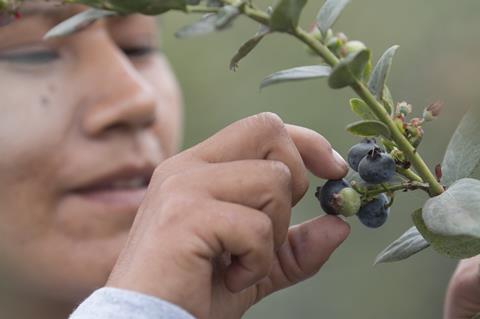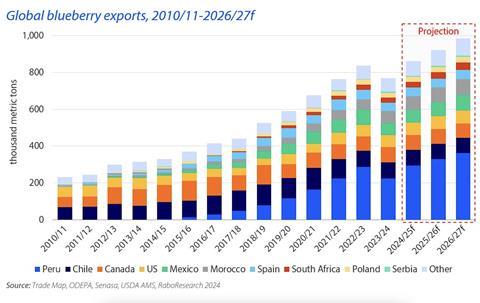RaboResearch report suggests rapid changes will ensure continued success for the worldwide blueberry industry
A series of significant changes across various regions will set the global blueberry industry up for continued success.

Key trends shaping the future of the industry include increasingly advanced genetics and growers’ heightened focus on labour productivity and efficiencies, according to a recent study by RaboResearch.
Blueberry export growth to resume
The 2023/24 blueberry season was unique, the report said, marking the first decline in exports in 15 seasons due to weather events that reduced production in leading countries.
Overall, global exports fell by 10 per cent. Additionally, the recovery of production and exports is expected to take longer than initially anticipated.
“For 2024/25, we expect record exports, but only 3 per cent higher than the 2022/23 season,“ said David Magaña, senior analyst – fresh produce for RaboResearch.
“In the following seasons, we anticipate a return to previous growth rates, potentially surpassing the one million metric ton milestone by the 2027/28 season.”
Peru leads the way
Though China will remain the global leader in production, it will continue to import South American supply during the counter-season, with a focus on quality, RaboResearch outlined.
In the 2023/24 season, South American blueberry exports recorded their first decline in 11 seasons and only the second since the 2001/02 campaign.
Nevertheless, Peru will continue to dominate global blueberry trade, the study confirmed, though the underlying factors that contribute to growth are changing.
“Variety renewal will sustain further growth in fresh blueberry exports,” explained Magaña. “A portion of new plantings will replace old varieties and orchards. And with a higher share of new proprietary varieties, we expect further growth, driven by higher yields rather than an increase in planted area.”
A diversified portfolio of new cultivars will enable growers across various regions to extend the production season in the near future, RaboResearch commented.
In Peru, the peak season is expected to stretch from a few weeks in previous seasons to a couple of months in the midterm.
This flattened production curve will allow a more organised marketing process, ”preventing market saturation and the associated price drops”.

Labour availability
Labour will remain a major challenge for growers worldwide, the report said.
In most regions, the labour force is decreasing, which will only increase competition for labor from other sectors.
For labour-intense crops like blueberries, recruiting sufficient workers and managing their housing and transportation is a significant challenge for growers, in particular during the harvest period.
“As labour becomes more of a challenge, we expect producers to increase their focus on this issue and implement changes, including switching to varietals with bigger berries or improved berry detachability, adopting machine harvesting, automating pre- and post-harvest processes, reducing the number of harvesting runs, and extending the season,” noted Magaña.
“Machine harvesting is undergoing a steep learning curve and must align with the orchard structure and variety grown,” he added. ”If all these factors are addressed, it will become successful. The question is when.”



